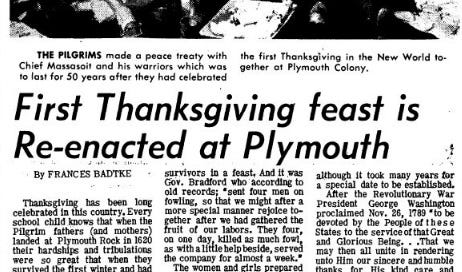“First Thanksgiving feast is Re-enacted at Plymouth” from the November 25, 1968 Door County Advocate
THE PILGRIMS made a peace treaty with Chief Massasoit and his warriors which was to last for 50 years after they had celebrated the first Thanksgiving in the New World together at Plymouth Colony.
First Thanksgiving feast is Re-enacted at Plymouth
By FRANCES BADTKE
Thanksgiving has been long celebrated in this country. Every school child knows that when the Pilgrim fathers (and mothers) landed at Plymouth Rock in 1620 their hardships and tribulations were so great that when they survived the first winter and had a good crop to show for their summer efforts, they decided to give thanks to the Lord for looking over them and protecting them through all their adversity.
The first Thanksgiving in 1621 was a big three-day event, enlivened by games of skill, shooting contests and a seemingly never-ending feast. The long tables outside under the trees groaned with the heavy load of good things to eat, a far cry from their first winter in the New World.
At Plymouth, Mass. each year is enacted the first Thanksgiving, complete with costumes, 17th century foods and athletic events and contests of skill between the “Pilgrims” and “Indians” participating.
There were 102 Pilgrims who landed in 1620. Of these only half survived to celebrate. They labored long and hard to build a village of log houses. They planted crops, learning to put a fish in each hill of corn as the Indians did. When their harvest was gathered they had good reason to rejoice, for this winter they would be eating, not starving and freezing as they had the first year.
John Carver was first governor and upon his untimely death the first winter, William Bradford, 31, was selected to govern the band of immigrants in his stead. Bradford’s wife had also been among those who had not survived the rigors of that Massachusetts winter.
It was Governor Bradford who invited the Indian Chief Massasoit and his tribe to join the grateful survivors in a feast. And it was Gov. Bradford who according to old records; “sent four men on fowling, so that we might after a more special manner rejoice together after we had gathered the fruit of our labors. They four, on one day, killed as much fowl, as with a little help beside, served the company for almost a week.”
The women and girls prepared the food for the celebration and in addition to shellfish, bread, greens, berries and plums, they also had wild turkeys, quail and other game to prepare.
Long plank tables were set up under the trees and shortly after dawn on the first Thanksgiving day, Chief Massasoit and 90 of his tribe appeared to help celebrate the great harvest. Records of the day tell us that the Pilgrims had harvested 20 acres of corn, six of wheat, barley and peas, although the pea crop was a failure.
The Indians, wishing to contribute to the already ample provender, went into the woods and brought back five deer for the Pilgrims. One of these was roasted and eaten at the three-day feast and the others saved for winter,
This was not an annual observance as it is now, and the second Thanksgiving Day was not celebrated until July 30, 1623 when a ship of fresh supplies arrived from England for the colonists. Thanks were also given to the Lord for bountiful crops again that fall, and Nov. 25, 1628 was appointed Thanksgiving Day. The Plymouth colony records show that the day was set aside for feasting and rejoicing.
The Indians had also had their days of Thanksgiving throughout the year, so this custom was not entirely strange to them. An autumn festival of the Iroquois Indians lasted three days and was called the Green Corn Dance.
The custom of a Thanksgiving feast persisted in the Colonies, although it took many years for a special date to be established.
After the Revolutionary War President George Washington proclaimed Nov. 26, 1789 “to be devoted by the People of these States to the service of that Great and Glorious Being. . .That we may then all unite in rendering unto Him our sincere and humble thanks for His kind care and protection of the People of this country.”
In 1815 President James Madison proclaimed a Thanksgiving Day because of the ending of the War of 1812. For a number of years thereafter it was not celebrated on a large scale until Mrs. Sara Josepha Hale, editor of “Godey’s Lady’s Book” took up the torch in its defense.
For years she worked (through her women readers mostly) toward getting national support in making Thanksgiving Day as much a national holiday as the Fourth of July.
She sent a copy of President George Washington’s original proclamation to Abraham Lincoln, who was then in the White House. Finally in 1863. President Lincoln proclaimed the last Thursday in November to be celebrated each year as Thanksgiving Day.
During World War II President Franklin D. Roosevelt named the third Thursday in November as Thanksgiving Day, making for a great deal of confusion, but more business for turkey growers and grocery stores, since many insisted upon celebrating the fourth Thursday of the month as well as the third Thursday.
This lasted only during 1939 and 1940. In order to make it clear which day really was Thanksgiving, a joint resolution of Congress in 1941 made it a law and provided that: “the fourth Thursday of November in each year after the year 1941 be known as Thanksgiving Day and it is hereby made a legal public holiday to all intents and purposes.”
Courtesy of the Door County Library Newspaper Archive
[The old records quoted are a letter written by Edward Winslow: http://mayflowerhistory.com/letter-winslow-1621 ]
Articles related to Thanksgiving Day
https://doorcounty.substack.com/t/thanksgiving-day
Articles by Frances Badtke
https://doorcounty.substack.com/t/frances-badtke



